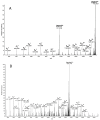Imaging Cataract-Specific Peptides in Human Lenses
- PMID: 36552806
- PMCID: PMC9776990
- DOI: 10.3390/cells11244042
Imaging Cataract-Specific Peptides in Human Lenses
Abstract
Age-related protein truncation is a common process in long-lived proteins such as proteins found in the ocular lens. Major truncation products have been reported for soluble and membrane proteins of the lens, including small peptides that can accelerate protein aggregation. However, the spatial localization of age-related protein fragments in the lens has received only limited study. Imaging mass spectrometry (IMS) is an ideal tool for examining the spatial localization of protein products in tissues. In this study we used IMS to determine the spatial localization of small crystallin fragments in aged and cataractous lenses. Consistent with previous reports, the pro-aggregatory αA-crystallin 66-80 peptide as well as αA-crystallin 67-80 and γS-crystallin 167-178 were detected in normal lenses, but found to be increased in nuclear cataract regions. In addition, a series of γS-crystallin C-terminal peptides were observed to be mainly localized to cataractous regions and barely detected in transparent lenses. Other peptides, including abundant αA3-crystallin peptides were present in both normal and cataract lenses. The functional properties of these crystallin peptides remain unstudied; however, their cataract-specific localization suggests further studies are warranted.
Keywords: cataract; imaging mass spectrometry; ocular lens; protein degradation.
Conflict of interest statement
The authors have no potential conflict of interest to declare.
Figures






Similar articles
-
Proteomic analysis of water insoluble proteins from normal and cataractous human lenses.Mol Vis. 2007 Sep 14;13:1680-94. Mol Vis. 2007. PMID: 17893670
-
Localization of low molecular weight crystallin peptides in the aging human lens using a MALDI mass spectrometry imaging approach.Exp Eye Res. 2010 Jul;91(1):97-103. doi: 10.1016/j.exer.2010.04.010. Epub 2010 Apr 28. Exp Eye Res. 2010. PMID: 20433829
-
Crystallins in water soluble-high molecular weight protein fractions and water insoluble protein fractions in aging and cataractous human lenses.Mol Vis. 2004 Jul 19;10:476-89. Mol Vis. 2004. PMID: 15303090
-
The Proteome of Cataract Markers: Focus on Crystallins.Adv Clin Chem. 2018;86:179-210. doi: 10.1016/bs.acc.2018.05.005. Epub 2018 Jul 13. Adv Clin Chem. 2018. PMID: 30144840 Review.
-
The etiology of human age-related cataract. Proteins don't last forever.Biochim Biophys Acta. 2016 Jan;1860(1 Pt B):192-8. doi: 10.1016/j.bbagen.2015.08.016. Epub 2015 Aug 28. Biochim Biophys Acta. 2016. PMID: 26318017 Free PMC article. Review.
Cited by
-
Identification of Age- and Cataract-Related Changes in High-Density Lens Protein Aggregates.Invest Ophthalmol Vis Sci. 2025 May 1;66(5):34. doi: 10.1167/iovs.66.5.34. Invest Ophthalmol Vis Sci. 2025. PMID: 40408093 Free PMC article.
References
-
- Congdon N., Vingerling J.R., Klein B.E.K., West S., Friedman D., Kempen J., O’Colmain B., Wu S.-Y., Taylor H.R. Eye Diseases Prevalence Research Group Prevalence of Cataract and Pseudophakia/Aphakia Among Adults in the United States. Arch. Ophthalmol. 2004;122:487–494. doi: 10.1001/archopht.122.4.487. - DOI - PubMed
-
- Takemoto L. Quantitation of C-terminal modification of alpha-A crystallin during aging of the human lens. Exp. Eye Res. 1995;60:721–724. - PubMed
-
- Wilmarth P.A., Tanner S., Dasari S., Nagalla S.R., Riviere A., Bafna V., Pevzner P.A., David L.L. Age-related changes in human crystallins determined from comparative analysis of post-translational modifications in young and aged lens: Does deamidation contribute to crystallin insolubility? J. Proteome Res. 2006;5:2554–2566. doi: 10.1021/pr050473a. - DOI - PMC - PubMed
Publication types
MeSH terms
Substances
Grants and funding
LinkOut - more resources
Full Text Sources
Medical

